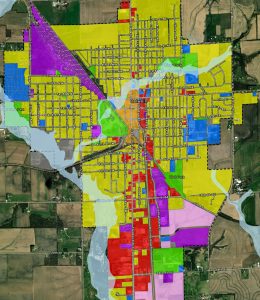This is the third article in a series focused on how the built environment influences public health. Part I provided readers an overview of the various places where planning and public health overlap, and Part II examined the role of green spaces and third places in promoting health through recreation and socialization. In Part III, we’ll underscore the importance of making informed, evidence-based policy decisions in land use, zoning, and transportation systems to positively influence citizen health.
Health implications of the built environment, whether positive or negative, originate from policy and decisions regarding use of spaces and development practices.
This acknowledgement was first legally recognized in A Standard State Zoning Enabling Act, originally drafted by the Department of Commerce in 1922, which allowed jurisdictions to manage land uses to separate incompatible uses and protect property. Over the past century, as technologies and development patterns have evolved, so has our awareness of human impacts from the built environment, and so should the policies and systems that shape our world.
Land Use

Example community land use map
Land use refers to how land and its resources are developed and managed. The American Public Health Association recognizes nine land use designations (residential, commercial, industrial, agricultural, transportation, institution, recreation, non-renewable resources, and disposal) with 11 primary factors that influence the health outcomes of these uses including:
- Site opportunities and potentials
- Density
- Agricultural capacity of available land
- Accessibility of facilities, services, and employment
- Diversification of uses
- Aesthetics, broad and local
- By-product management—recycling
- Hazards to life and property
- Efficient utilization for chosen uses
- Conservation of all land resources
- Legal and other factors necessarily considered
Themes in health-oriented land use policy that account for these factors revolve around a delicate balance between allowances that provide diversification of neighborhoods and restrictions that prevent adjacency of incompatible uses that inflict harm on human and environmental health. This balance is challenging to achieve, especially with our nation’s current regression in reliance of scientific evidence for health-based policy. Furthermore, land use decisions are often influenced by market circumstances that fluctuate and, while economic sustainability is vital for a healthy community, these influences do not generally account for the physical and mental health implications of development practices.
Zoning

Zoning regulations are a tool used to implement land use guidance with more detailed definitions of uses and appropriate development practices. These regulations dictate where development occurs and how, which can impact the availability of amenities crucial for public health, such as green spaces, recreational facilities, and access to healthy food options. Poorly designed zoning can contribute to food deserts, where fresh produce is scarce, and can limit opportunities for physical activity, leading to higher rates of obesity and related diseases. Additionally, zoning decisions can affect air and water quality, as industrial or commercial zones near residential areas may increase pollution levels, leading to respiratory issues and other health concerns for nearby residents.
Permitted rights determine what is allowed without review or conditions and have long been included in zoning classifications. However, as evidence of health impacts from chemicals used in what have traditionally been considered commercial facilities — such as fuel pumps or dry cleaners — has become more widely accepted, the need to separate these and similar uses from residential areas and low-impact commercial facilities such as retail and restaurants is apparent. Zoning, even more so than the guiding principles of land use, requires detailed scrutiny and balance to fulfill the intentions of protecting public health. Practitioners and local leaders responsible for zoning decisions should be well-informed of potential health impacts from land use and zoning decisions and should work toward developing local policies that protect the general health of residents and the environment.
Transportation

Transportation systems implicate myriad impacts upon human health. Access to resources and general mobility opportunities impact both physical and mental health, while pollution from these transportation systems impose inescapable health repercussions on entire communities. Transportation sources are responsible for over half of the emissions of the three air toxins considered the greatest public health concerns, along with many additional carcinogens. Extended exposure to transportation-related pollutants such as those living, working, or going to school near major thoroughfares and transportation centers increases the likelihood of asthma, atherosclerosis, and other respiratory and cardiovascular diseases among people of all ages. Along with health risks from pollutants and mobility challenges, traffic fatalities are a leading cause of death for people under 54 in the United States, with teens facing a higher risk factor than their elders.
Policy Change
Policy change can seem inconsequential amongst the complexity of our interrelated health challenges imposed from the built environment. But policy is the foundation of our culture. In 2007 the rate of cigarette smokers amongst Iowa adults was approximately 22%. The State passed the Iowa Smokefree Air Act on July 1st, 2008, and by 2021 the smoking rate among the same population dropped to 15%. It is also estimated that states that raise the tobacco purchasing age to 21 or above reduce the number of teenagers who begin smoking cigarettes between ages 15 and 17 by 25%. Limiting exposure and access to harmful practices sets precedence for healthy decisions, enables individuals to lead healthy lifestyles, and reduces the impact of secondary exposure to harm.
Similarly to reduction of cigarette use, we can normalize enacting and enforcing policies that impact the general wellbeing of individuals and the environment through more thoughtful zoning practices and evidence-based land use guidance. Relying on environmental and public health data to guide land use and development policies will improve conditions for humans and our natural resources.

Transportation policy is primarily influenced from the national level, as transportation systems including funding processes are mostly funneled from federal sources. Municipalities across the nation are applying for Safe Streets and Roads for All (SS4A) funding. The goal of this program is to develop action plans and implement projects for transportation systems that focus on reducing traffic fatalities and serious injuries. A requirement of the program is for municipalities to have a vision zero goal – an official public commitment from an official or governing body to aim for zero roadway fatalities and serious injuries, often accomplished by ordinance or resolution. Results from the program are limited, as it began in 2022. However, since it was released, SS4A has provided transportation improvements in over 1,000 municipalities throughout the United States and Puerto Rico.
Tools for Decision-Making
Just as health implications from the built environment are intertwined across sectors, so are solutions to improved policies and systems. Major health organizations across the globe including the Center for Disease Control and the World Health Organization support a collaborative approach to systems change known as Health in All Policies (HiAP). This approach recognizes the abundant influences of public health and aims to integrate health considerations into policy and decision making in various sectors including transportation, agriculture, land use, housing, public safety, and education. Although implementation for change is largely dependent on place-based processes, there are five key elements of HiAP imperative for success:
- Promote health and equity.
- Support intersectoral collaboration.
- Benefit multiple partners.
- Engage stakeholders.
- Create structural or procedural change.
Successful implementation of HiPA has emerged in cities across the United States including Houston, San Diego, and Baltimore. More information about HiPA for states and local governments can be found here.
Other tools for enacting health policies include Geographic Information Systems (GIS) and Health Improvement Assessments (HIA). GIS can be used to track and visualize patterns in health trends. This can help health professionals identify recurring patterns of health impacts from the built environment such as the correlation of asthma in proximity to transportation centers and major thoroughfares or the prevalence of obesity and related health concerns in food deserts and areas with insufficient nontraditional transportation.

HIA supports HiPA by assessing the potential health outcomes of policies and programs at or prior to implementation. The foundational methodology for HIA follows five basic steps: screening, scoping, assessment, recommendation, and evaluation. This front-side assessment phase differs from program evaluation, in that future outcomes are anticipated, allowing policies and programs to adjust, if necessary, while evaluation examines the final outcome of interventions that have already happened. Two crucial factors of HIA are citizen participation and baseline assessment. Citizen participation enhances quantitative data with qualitative support of potential socioeconomic impacts on individuals, which influences physical and mental health. Baseline assessments provide comparative scenarios from which to contrast potential results. HIA evaluates both intended and unintended impacts, providing insight to inadvertent consequences, whether beneficial or detrimental. More information about HIA can be found here.
Conclusion
The intricate relationship between the built environment and public health underscores the importance of informed, evidence-based policy decisions in land use, zoning, and transportation systems. Historical recognition of these connections, dating back to the 1922 Standard State Zoning Enabling Act, highlights the enduring relevance of these issues. Balancing economic sustainability with health outcomes is crucial, as demonstrated by the American Public Health Association’s land use designations and influencing factors. Effective zoning and transportation policies, guided by scientific evidence, can mitigate negative health impacts, such as pollution and physical inactivity, while promoting accessibility and safety. It is critical to utilize modern tools to best inform decision-making. Moving forward, a commitment to integrating public health considerations into all aspects of the built environment will be essential for fostering environments where both individuals and communities can thrive.
